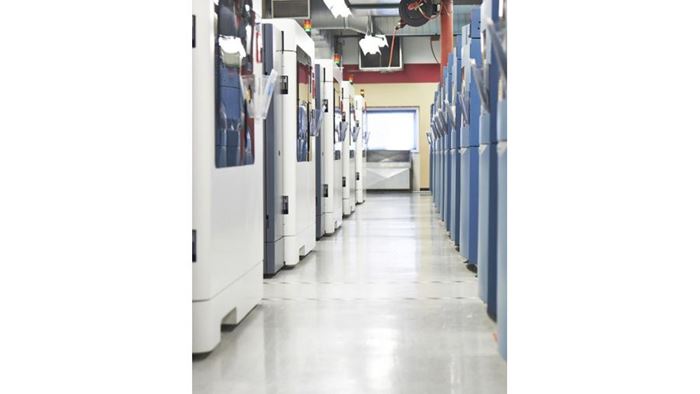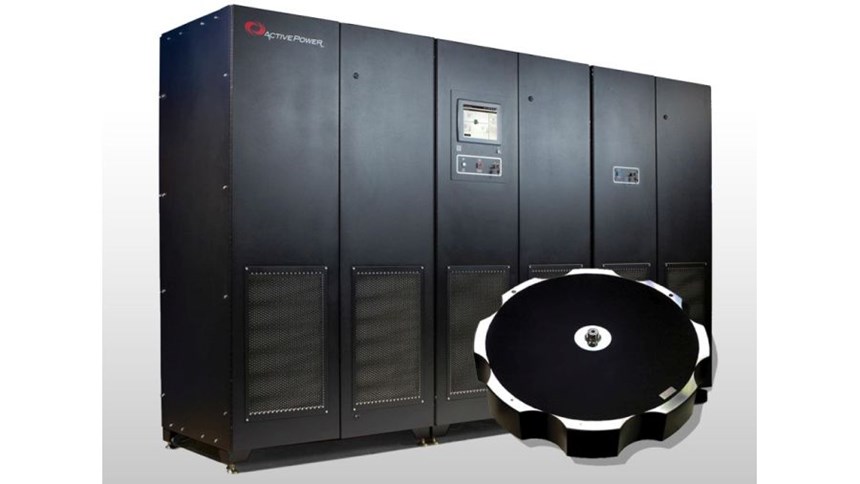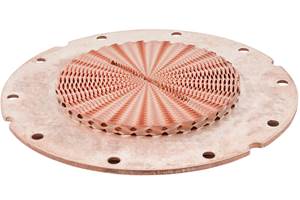Calling for Backup: Power Protection
An additive manufacturing service provider solved quality issues with an uninterrupted power supply, enabling more reliable production.
Share
Read Next
As today’s industrial and manufacturing processes rapidly become more digitized, power quality is a growing concern. Electrical interruption can cause major problems for all manufacturing operations, but can be especially devastating for 3D printing and additive manufacturing facilities.
Even a short power disruption lasting a few seconds can disrupt an entire day’s worth of production, resulting in scrapped product, missed shipments, poor product quality and reduced labor productivity. Power disturbances can be particularly costly for those manufacturers who have a large number of machines in place to produce parts in high volume. Increasing demands for timely shipments, perfect quality and lowest cost only exacerbate the impact power issues can have on these applications. For these reasons, additive manufacturers simply cannot afford to experience an electrical interruption, prompting one manufacturer to install uninterruptible power supply (UPS) systems at its facilities to protect its 3D printing machines.
Stratasys Direct Manufacturing is one of the world’s largest providers of advanced manufacturing services with more than 500 employees across seven facilities in the United States. Many of the company’s 3D printing machines produce flight-certified aircraft components. At some of its factories, Stratasys Direct Manufacturing was experiencing micro-outages (less than 0.5 seconds) every year. These events forced the manufacturer to stop production, clean out the machines and restart them. In some instances, a momentary power outage could cause an entire batch of parts in process to fail strict customer requirements for mechanical strength, making it clear to company executives that something had to be done.
UPS: The Solution
One common solution to the problems faced by Stratasys Direct Manufacturing is to deploy a UPS to protect against power quality issues. UPS systems serve two main purposes: to condition incoming utility power and to provide short-term power protection in the event of a power disturbance or micro-outage.
“Prior to the UPS installations, we experienced several micro-outages every year at each of our facilities,” said Greg Reynolds, vice president, additive manufacturing, at Stratasys Direct Manufacturing. “These electrical disturbances can interrupt production and could potentially cause products in process to be discarded. This could drive up our costs or strain the production schedule.”
The two primary types of UPS systems are battery-based and flywheel, with the main difference being the energy storage technology used. A conventional battery-based system stores energy in valve-regulated lead acid (VRLA) batteries, and then converts the energy to electricity through a chemical reaction. Flywheel-based systems store kinetic energy in a spinning mass until called upon by the equipment it is protecting.
Battery-based UPS systems have long been the industry standard because they can provide several minutes of backup power. However, batteries require frequent maintenance and replacement (typically every 4 to 6 years), must be housed in cabinets that can take up a great deal of space and do not fare well in high ambient temperatures, such as those seen in factory environments. Further, batteries used in UPS applications are designed for standby use, not for the frequent discharges seen in manufacturing applications. This reduces battery runtime and eventually requires more frequent replacement cycles, making them expensive to operate over the long run.
Because they have no batteries, flywheel-based UPS systems require less maintenance and component replacements and can operate in much higher ambient temperatures. This, along with a smaller footprint, allows operators to install the flywheel UPS directly on the factory floor. The flywheel UPS suffers no runtime degradation when discharged and can be called upon to protect a load frequently and deeply for its 20-year life, while providing the same amount of stored energy as on day one. In fact, flywheel UPS systems are 12 times less likely to fail compared to battery-based UPS offerings, according to a white paper published by Active Power.
Typically, flywheel-based UPS systems offer lower operating expenses than their battery-based counterparts due to their high energy efficiency, permanent energy storage and lower maintenance requirements, all of which contribute to a lower total cost of ownership (TCO). In some scenarios, flywheel UPS can deliver up to 40 percent TCO savings over a 15-year period.
Flywheel UPS systems are also often the “greener” solution when compared to battery systems. Manufacturing a flywheel takes one-ninth the carbon emissions caused in manufacturing batteries, and the higher operating efficiency means a reduction of as much as 40 percent in wasted electricity, resulting in up to 40 percent less carbon emissions during operation. And unlike lead-acid batteries, flywheel systems do not contain any hazardous materials or require special ventilation or safety equipment.
Flywheel UPS
For its operations, Stratasys Direct Manufacturing chose to deploy Active Power CleanSource flywheel UPS systems rather than battery-based units due to their reliability, smaller footprint and lower TCO. These UPS protect critical additive manufacturing machines and supporting equipment in the factories. To date, Stratasys Direct Manufacturing has deployed nearly 1 megawatt of flywheel UPS capacity across three of its facilities.
“We evaluated a number of UPS suppliers, but ultimately chose Active Power’s battery-free solution because of its superior reliability,” said Reynolds. “Since the install, we’ve had a few short power disturbances and the Active Power UPS systems have performed flawlessly. Our 3D printers at times are running atypical voltages and require transformation, so having flexibility in deployment was important. Put simply, power quality is no longer a concern and allows our employees to focus all of their attention on meeting customer requirements and shipping deadlines. The UPS deployments also demonstrate our commitment to customers, help us gain status as a preferred supplier and mitigate the risk of lost builds.”
Choosing the right UPS can make a huge difference in the productivity and profitability of an additive manufacturer. High-volume production 3D printing can benefit from a UPS as it can protect parts quality and material integrity and minimize downtime during long production runs. On the sustainability front, flywheel UPS generate less carbon emissions compared to battery-based UPS products and do not contain any hazardous or dangerous chemicals, supporting green efforts.
Facility managers at Stratasys Direct Manufacturing took the time to determine which product was right for their operations and are satisfied with the end result. Other manufacturers should do the same when selecting a UPS for their operations, considering the pros and cons of both battery and flywheel UPS systems, since no two facilities have the same needs or concerns.
Todd Kiehn is the vice president of marketing and modular solutions for Active Power Inc. in Austin, Texas, a manufacturer of flywheel technology solutions for mission critical and renewable applications worldwide. Kiehn leads all marketing, positioning and product development efforts in the mission critical, modular infrastructure and energy storage markets. He also directs strategy across the company’s organizations and its product portfolio including CleanSource UPS, CleanSource HD UPS, and CleanSource PowerHouse, a complete modular electrical infrastructure solution. Kiehn can be reached at tkiehn@activepower.com.
Related Content
3D Printed Titanium Replaces Aluminum for Unmanned Aircraft Wing Splice: The Cool Parts Show #72
Rapid Plasma Deposition produces the near-net-shape preform for a newly designed wing splice for remotely piloted aircraft from General Atomics. The Cool Parts Show visits Norsk Titanium, where this part is made.
Read MoreWith Electrochemical Additive Manufacturing (ECAM), Cooling Technology Is Advancing by Degrees
San Diego-based Fabric8Labs is applying electroplating chemistries and DLP-style machines to 3D print cold plates for the semiconductor industry in pure copper. These complex geometries combined with the rise of liquid cooling systems promise significant improvements for thermal management.
Read MoreBeehive Industries Is Going Big on Small-Scale Engines Made Through Additive Manufacturing
Backed by decades of experience in both aviation and additive, the company is now laser-focused on a single goal: developing, proving and scaling production of engines providing 5,000 lbs of thrust or less.
Read More8 Cool Parts From Formnext 2024: The Cool Parts Show #78
End-use parts found at Formnext this year address various aspects of additive's advance, notably AM winning on cost against established processes.
Read MoreRead Next
Bike Manufacturer Uses Additive Manufacturing to Create Lighter, More Complex, Customized Parts
Titanium bike frame manufacturer Hanglun Technology mixes precision casting with 3D printing to create bikes that offer increased speed and reduced turbulence during long-distance rides, offering a smoother, faster and more efficient cycling experience.
Read MorePostprocessing Steps and Costs for Metal 3D Printing
When your metal part is done 3D printing, you just pull it out of the machine and start using it, right? Not exactly.
Read MoreProfilometry-Based Indentation Plastometry (PIP) as an Alternative to Standard Tensile Testing
UK-based Plastometrex offers a benchtop testing device utilizing PIP to quickly and easily analyze the yield strength, tensile strength and uniform elongation of samples and even printed parts. The solution is particularly useful for additive manufacturing.
Read More





















